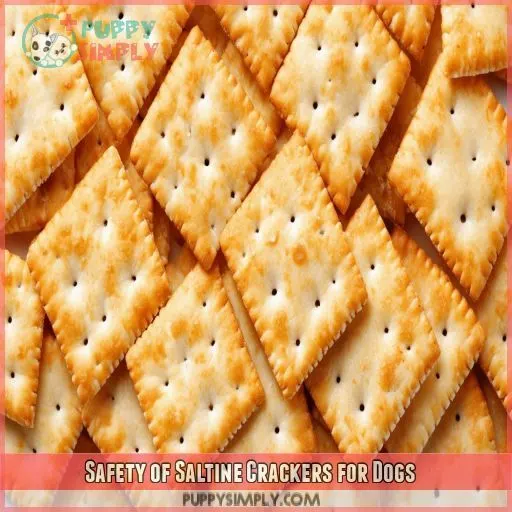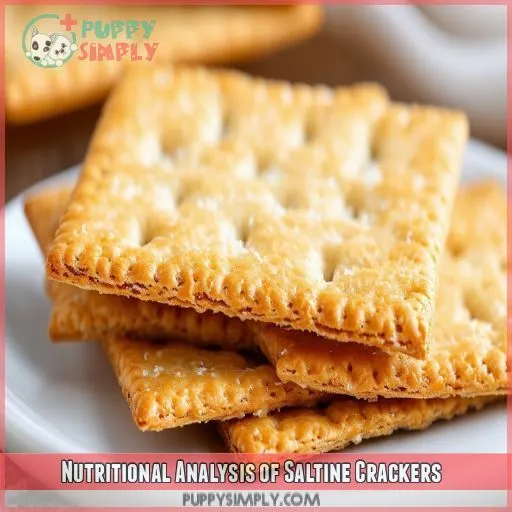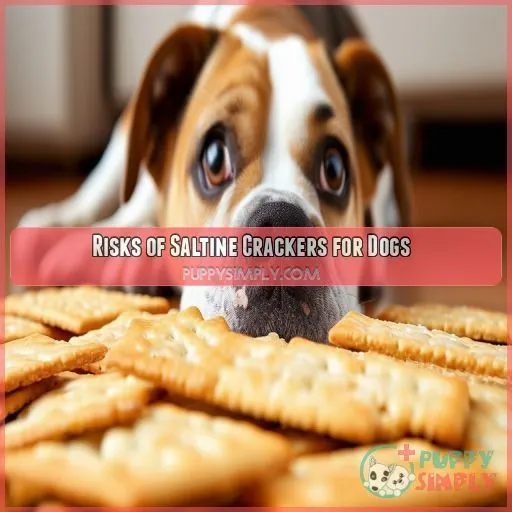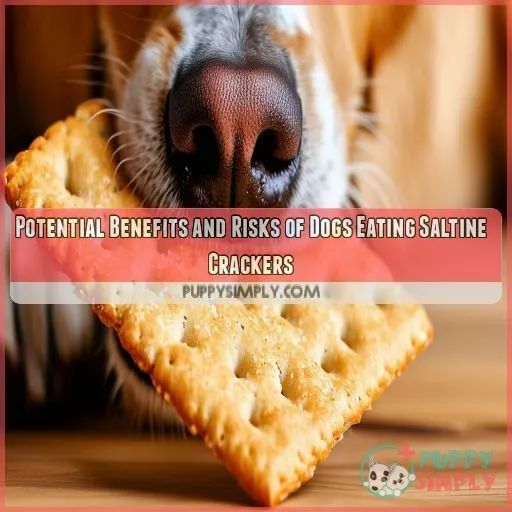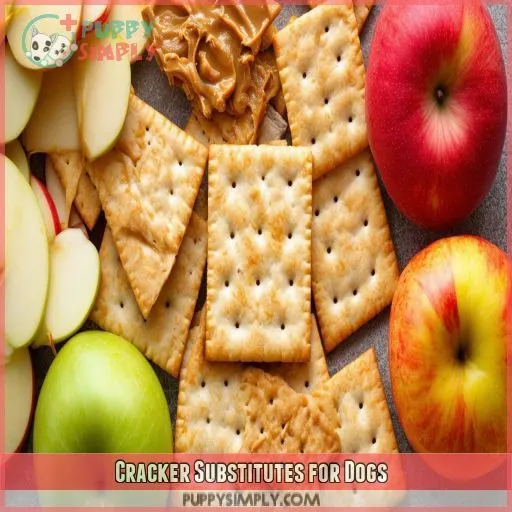This site is supported by our readers. We may earn a commission, at no cost to you, if you purchase through links.
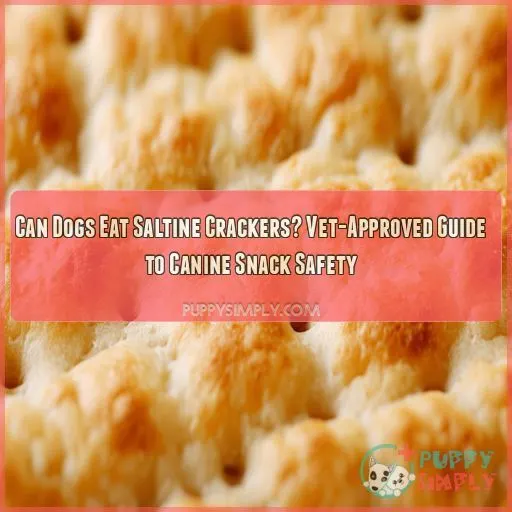 You shouldn’t feed your dog saltine crackers due to their high sodium content and potential health risks. While a small piece might not be immediately harmful, regular consumption can lead to digestive issues, blood pressure problems, and even salt poisoning. These crackers also lack nutritional value for your furry friend.
You shouldn’t feed your dog saltine crackers due to their high sodium content and potential health risks. While a small piece might not be immediately harmful, regular consumption can lead to digestive issues, blood pressure problems, and even salt poisoning. These crackers also lack nutritional value for your furry friend.
Instead, opt for healthier alternatives like fresh fruits and vegetables or vet-approved dog treats. If you’re looking for a safe snack option, consider whole grain or gluten-free crackers specifically made for dogs.
Always consult your vet before introducing new foods to your pup’s diet. There’s more to know about keeping your canine companion’s snacks safe and healthy.
Table Of Contents
- Key Takeaways
- Can Dogs Eat Saltine Crackers?
- Safety of Saltine Crackers for Dogs
- Nutritional Analysis of Saltine Crackers
- Risks of Saltine Crackers for Dogs
- Can Dogs Consume Saltine Crackers Safely?
- Healthier Alternatives to Saltine Crackers
- Potential Benefits and Risks of Dogs Eating Saltine Crackers
- Cracker Substitutes for Dogs
- Consultation With Veterinarian for Dog’s Diet
- Frequently Asked Questions (FAQs)
- Is it okay to give my dog saltine crackers?
- What kind of crackers can dogs eat?
- Are saltine crackers safe?
- Can a dog eat Ritz crackers?
- Are saltine crackers bad for dogs?
- Can dogs eat crackers?
- How much sodium is in saltine crackers?
- Can dogs eat sourdough crackers?
- Can dogs eat soda crackers?
- Can dogs eat multigrain crackers?
- Can saltine crackers help with a dogs upset stomach?
- How many saltine crackers can a puppy safely eat?
- Are flavored saltine crackers more dangerous for dogs?
- Can dogs develop a craving for saltine crackers?
- Do saltine crackers affect a dogs dental health?
- Conclusion
Key Takeaways
- Saltine crackers are a no-go for Fido. They’re packed with sodium that could send your pup’s blood pressure through the roof!
- While a tiny nibble won’t have your pooch keeling over, regular snacking on these salty squares could lead to digestive drama and even salt poisoning. Talk about a rough situation!
- Instead of saltines, treat your furry friend to some tail-wagging alternatives like crunchy carrot sticks or apple slices. Your dog’s tummy (and your vet) will thank you!
- When in doubt, always bark up the right tree by consulting your veterinarian. They’re the top dogs when it comes to your pup’s dietary needs and can help you sniff out the best treats for your four-legged companion.
Can Dogs Eat Saltine Crackers?
Yes, dogs can eat saltine crackers, but only in small amounts as an occasional treat. Saltine crackers aren’t toxic to dogs, but their high sodium content and lack of nutritional value make them an unsuitable regular snack for canine companions.
Safety of Saltine Crackers for Dogs
When considering saltine crackers for your dog, it’s essential to understand the potential health implications of their high sodium content and additives. You’ll need to be aware of possible allergic reactions or digestive sensitivities your dog might experience, as these crackers aren’t designed with canine nutrition in mind.
Sodium and Health Implications
You might think saltine crackers are harmless, but they’re not ideal for your furry friend. High sodium intake can lead to digestive consequences and blood pressure issues in dogs. While an occasional nibble won’t hurt, regularly feeding saltines can impact your pup’s weight control and overall health. It’s best to prioritize dog-specific treats for optimal nutrition and safety.
Additives and Potential Risks
Additives in saltine crackers can pose risks for dogs, resulting in allergic reactions and digestive issues. Sodium concerns are paramount, as high levels can harm your pet’s health. It’s essential to monitor dog food ingredients and feeding practices to ascertain that additives in dog treats don’t negatively impact their well-being.
Allergies and Digestive Sensitivities
Moving from additives, let’s delve into allergic reactions and digestive sensitivities. Dogs can have adverse reactions to certain ingredients, so keep an eye on:
- Sodium Intake: Even small amounts can cause issues.
- Additive Risks: Preservatives, flavors, and colors can cause allergies.
- Ingredient Scrutiny: Always check labels for harmful substances.
Nutritional Analysis of Saltine Crackers
When evaluating saltine crackers for your dog, consider the sodium content, carbohydrate levels, and protein composition. Understanding these nutritional aspects can guide you in making informed choices for your canine companion’s snacks.
Sodium Content Overview
Regarding sodium levels, saltine crackers have 140mg per five, which can quickly exceed safe limits for dogs. Excessive sodium can cause severe health problems, including salt poisoning. It’s crucial to monitor servings and consider low-sodium, veterinarian-approved options to safeguard your dog’s health (Source).
Carbohydrates and Fiber
Concerning saltine crackers, you’ll find they’ve 11.2g of carbohydrates but only 0.4g of fiber per 5 crackers. Here’s why that matters:
- Carbohydrate digestion: Fuel for energy.
- Fiber benefits: Promote digestive health.
- Lack of fiber sources: Only 0.4g isn’t enough.
- Whole grain importance: Better fiber content.
Protein Composition
In terms of protein content, saltine crackers offer minimal benefit for dogs. Each serving of five crackers contains about 1.4 grams of protein, falling short of dogs’ dietary requirements (Source). While not harmful in moderation, these snacks don’t provide essential nutrients, impacting their nutritional adequacy .
Risks of Saltine Crackers for Dogs
Feeding your dog saltine crackers can lead to high sodium intake, which may cause serious health problems like salt poisoning. Additionally, additives and potential allergens in these crackers can disturb your dog’s digestive system and trigger allergic reactions.
High Sodium Concerns
Saltine crackers’ high sodium levels can cause serious health issues for dogs, such as digestive upset, allergic reactions, and weight gain . Always prioritize moderation and keep those tasty crisps out of reach; instead, explore dog food tips, dog food advice, and snag dog food coupons, discounts, or deals for healthier options.
Impact on Digestive Health
Saltine crackers, often made with white flour, can lead to digestive issues in dogs due to their high glycemic index and sodium content. Potential consequences include:
- Bloating: The high sodium can make your pup retain water.
- Weight Gain: Extra calories add up.
- Gastroparesis Symptoms: Cracker consumption may exacerbate these.
Consider healthier alternatives, like whole grains .
Potential Allergic Reactions
Feeding your dog saltine crackers can spike allergic reactions like skin irritation and digestive upset. It can also lead to weight gain and nutritional deficiencies. Be cautious and watch for symptoms such as itching, vomiting, or diarrhea. Here’s a quick table on cracking the risks:
| Allergic Reactions | Symptoms | Severity |
|---|---|---|
| Skin Irritation | Itching, Redness | Mild |
| Digestive Upset | Vomiting, Diarrhea | Moderate |
| Weight Gain | Increased Weight | High |
| Nutritional Deficiency | Lethargy | Severe |
| Salt Poisoning | Excessive Thirst | Critical |
Can Dogs Consume Saltine Crackers Safely?
You can safely give your dog saltine crackers moderately, but it’s imperative to monitor their consumption due to high sodium content (Source). Adjust the amount based on your dog’s size and activity level, and guarantee they always have access to fresh water .
Moderation Recommendations
When giving your dog saltine crackers, moderation is key. Because of their high sodium content, excessive consumption can lead to health issues, especially if your dog has allergic reactions or digestive sensitivities. Always opt for low-sodium alternatives and monitor their intake closely.
- Choose unsalted whole wheat crackers
- Offer occasionally
- Supervise your pet
Feeding Guidelines
When feeding saltine crackers to your dog, moderation is key. Stick to small amounts, considering your dog’s size and activity level. Opt for homemade treats for better nutritional value and to avoid digestive issues. Always prioritize vet consultation to confirm the safety and suitability of any new treat in your dog’s diet.
Monitoring Consumption
To guarantee your dog consumes saltine crackers safely, monitor their consumption closely. Here’s what to keep in mind:
- Watch for signs of digestive problems, such as vomiting or diarrhea
- Control portion sizes to avoid overfeeding and obesity risk
- Keep an eye on your dog’s sodium intake, as excessive consumption can lead to health issues
- Balance crackers with nutrient-rich foods for best nutritional value
- Consult with your veterinarian if you have any concerns
Healthier Alternatives to Saltine Crackers
When looking for healthier alternatives to saltine crackers for your dog, consider fresh fruits and vegetables like apples, blueberries, or carrots, which provide essential nutrients without high sodium. Additionally, opt for commercial dog treats made with natural ingredients, or try making your own vet-approved homemade treats to guarantee your dog gets the best nutrition.
Fresh Fruits and Vegetables as Options
For safe consumption and nutritional value, fresh alternatives like apples, blueberries, carrots, and green beans provide excellent homemade options for your dog’s snacks. These fruits and vegetables offer digestive benefits and are a healthier choice than saltine crackers.
Commercial Dog Treats Comparison
When considering commercial dog treats as healthier alternatives to saltine crackers, focusing on ingredient quality and nutritional value is essential. Look for:
- Low-calorie intake
- Natural flavor options
- High-quality ingredients
- Minimal health concerns
- Balanced nutritional profiles
Homemade Treats Consideration
Consider homemade treat recipes as a healthier alternative to saltine crackers for your dog. These provide variety for picky dogs using dog-friendly baking ingredients and may offer numerous health benefits, including nutritional supplements like fatty acids or fish oil .
Vet-Approved Treats Importance
Vet-approved dog treats guarantee your canine’s safety from allergens, digestive upset, and nutritional inadequacy while preventing excessive consumption.
- Healthier options:
- Low sodium content
- Made with natural ingredients
- Designed specifically for dogs’ needs
Potential Benefits and Risks of Dogs Eating Saltine Crackers
Saltine crackers can occasionally help with digestive issues and nausea in dogs, but their high sodium content poses significant health risks. Always consult with your veterinarian and monitor your dog’s intake to avoid potential complications.
Digestibility and Nausea Relief
Saltine crackers, with their bland flavor and low odor, can be easy to digest for dogs experiencing nausea. They can offer temporary relief due to their simple composition, which may simplify your dog’s stomach issues. However, they shouldn’t replace regular meals due to their limited nutritional value and high sodium content.
Nutritional Value Assessment
Saltine crackers have a high glycemic index due to their white flour content, which can lead to rapid blood sugar spikes. They’re low in essential nutrients, offering minimal health benefits for dogs. While they may be easy to digest, the high sodium content makes them a poor choice for regular treats .
Overconsumption Risks
While saltine crackers aren’t toxic, overconsumption can lead to several risks for your furry friend:
- Weight gain due to empty calories
- Digestive issues from excessive sodium
- Potential allergic reactions to wheat or additives
- Nutritional imbalance from filling up on low-value snacks
Cracker Substitutes for Dogs
If you’re looking for safer alternatives to saltine crackers for your dog, consider whole grain, nut and seed, or gluten-free options. These substitutes can provide a crunchy texture your dog will enjoy while offering more nutritional benefits and fewer risks than traditional saltine crackers.
Whole Grain Options
When considering whole grain options for your pup, you’re barking up the right tree! These treats offer a tail-wagging combo of digestive health and weight management benefits. Whole grains boost nutrient absorption, keeping your furry friend fit and frisky. Try whipping up homemade treats using oats or brown rice for a healthier crunch that’ll have them begging for more!
Nut and Seed Varieties
When considering nut and seed varieties for your dog, keep these points in mind:
- Check for nut allergies before introducing new treats
- Opt for easily digestible seeds like pumpkin or sunflower
- Look for crackers combining whole grains with nuts or seeds
- Try homemade varieties using dog-safe ingredients
Always introduce new snacks gradually and monitor your pup’s reaction.
Gluten-Free Alternatives
Looking for gluten-free options for your pup? You’re in luck! Grain-free alternatives can be a great choice. Try rice-based or chickpea crackers, which often have higher fiber content and nutritional value. You can even whip up some dog-friendly recipes at home. Remember, these treats should still be given in moderation to keep your furry friend healthy and happy.
Consultation With Veterinarian for Dog’s Diet
Consult your veterinarian to create a customized diet plan for your dog, including advice on safe treats and potential supplements. They’ll consider your pet’s specific health needs and help you develop a long-term strategy for ideal nutrition and wellness.
Importance of Professional Advice
While cracker substitutes can be tempting, it’s essential to consult your vet for personalized advice. They’ll consider your dog’s unique needs, addressing potential nutritional deficiencies and human health concerns. Your vet can recommend safe dog treat alternatives and help create a balanced diet plan customized to your furry friend’s specific requirements, ensuring their long-term well-being.
Supplement Consideration
After consulting your vet, you might consider supplements for your dog’s diet. When exploring supplement options, keep these key points in mind:
- Choose supplements with proven health benefits
- Follow dosage recommendations strictly
- Be aware of potential side effects
Always discuss long-term effects with your vet before adding any new supplement to your furry friend’s routine.
Long-Term Health Planning
Planning your dog’s long-term health isn’t a walk in the park. You’ll want to leash up with your vet to create a custom nutrition plan. They’ll sniff out the best alternative snacks, weigh in on homemade treats, and keep an eye on sodium consumption. Together, you’ll fetch a balanced diet that’ll have your pup wagging for years to come.
Frequently Asked Questions (FAQs)
Is it okay to give my dog saltine crackers?
You shouldn’t give your dog saltine crackers. They’re high in sodium and offer little nutritional value. While one won’t hurt, regular consumption can lead to health issues. Stick to dog-specific treats or healthier alternatives like fresh fruits and veggies.
What kind of crackers can dogs eat?
You can give your dog plain, unsalted crackers made with whole grains in moderation. Avoid saltines and flavored varieties. Opt for dog-specific treats or healthier alternatives like small pieces of fruits and vegetables for safer snacking options.
Are saltine crackers safe?
Like a wolf in sheep’s clothing, saltine crackers aren’t safe for your furry friend. They’re high in sodium and lack nutritional value. You’re better off offering dog-specific treats or healthy alternatives like carrot sticks or apple slices.
Can a dog eat Ritz crackers?
While you can give your dog a Ritz cracker occasionally, it’s not recommended. They’re high in fat and salt, which aren’t healthy for dogs. Stick to treats made specifically for canines to keep your furry friend safe and happy.
Are saltine crackers bad for dogs?
Imagine your pup eyeing those salty squares. You’re hesitant. Saltine crackers aren’t toxic, but they’re not ideal for dogs. They’re high in sodium and offer little nutritional value. It’s best to stick with dog-specific treats instead.
Can dogs eat crackers?
While dogs can eat certain crackers in moderation, it’s not recommended. They’re often high in salt and lack nutritional value. Opt for dog-specific treats or healthier alternatives like carrots or apples. Always consult your vet before introducing new foods.
How much sodium is in saltine crackers?
While saltines seem harmless, they’re surprisingly salty. You’ll find about 140mg of sodium in just five crackers. That’s 6% of your daily value. Watch out! Excessive sodium can lead to health issues, so moderation’s key.
Can dogs eat sourdough crackers?
You shouldn’t give your dog sourdough crackers. They’re not toxic, but they’re high in sodium and offer no nutritional benefits. Stick to dog-specific treats or healthier alternatives like small pieces of fresh fruits or vegetables.
Can dogs eat soda crackers?
Like a ship maneuvering choppy waters, your dog’s diet requires careful consideration. Soda crackers aren’t toxic, but they’re not ideal. They’re high in salt and offer little nutritional value. It’s best to stick to dog-specific treats.
Can dogs eat multigrain crackers?
While multigrain crackers are safer than saltines, they’re still not ideal for dogs. You can offer them occasionally as a treat, but it’s best to stick with dog-specific snacks. Always monitor portion sizes and check ingredients carefully.
Can saltine crackers help with a dogs upset stomach?
While saltine crackers won’t harm your dog in small amounts, they’re not ideal for upset stomachs. Instead, try bland foods like boiled chicken and rice. If your pup’s tummy troubles persist, it’s best to consult your vet.
How many saltine crackers can a puppy safely eat?
You shouldn’t feed your puppy saltine crackers. They’re high in sodium and lack nutritional value for growing dogs. If you must, limit it to a tiny piece occasionally. Better options include dog-specific treats or small bits of plain, cooked chicken.
Are flavored saltine crackers more dangerous for dogs?
Yes, flavored saltine crackers can be more dangerous for dogs. They often contain additives, spices, or ingredients like onion or garlic powder that are harmful to canines. It’s best to avoid giving your dog any flavored crackers.
Can dogs develop a craving for saltine crackers?
Dogs can become saltine fiends! While they won’t develop a physical addiction, they might beg for these salty snacks. You’re better off offering healthier treats. Don’t cave to those puppy eyes; your dog’s health comes first!
Do saltine crackers affect a dogs dental health?
Saltine crackers can harm your dog’s dental health. They’re sticky, clinging to teeth and promoting plaque buildup. The high sodium content may also irritate gums. It’s best to avoid them and choose dog-specific dental treats instead.
Conclusion
Regarding the question "can dogs eat saltine crackers," the answer is clear: it’s best to avoid them. While not immediately harmful, these snacks pose risks due to high sodium and low nutritional value.
Instead, focus on veterinarian-approved treats or wholesome alternatives like fresh fruits and vegetables. Always consult your veterinarian before introducing new foods to your dog’s diet.

